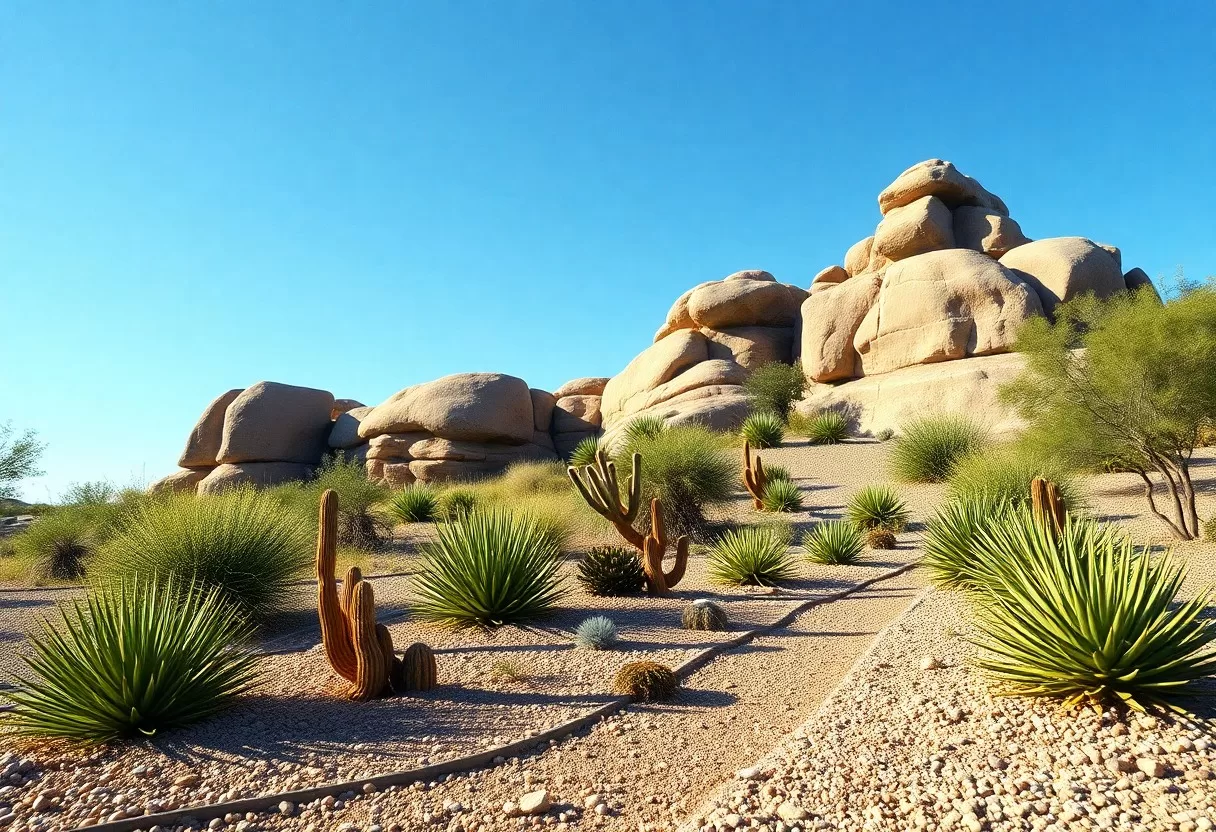Embrace Nature – A Comprehensive Guide To Drought-Tolerant Landscaping
Nature’s resilience is evident in drought-tolerant landscapes that thrive with minimal water. In this comprehensive guide, you will learn how to transform your outdoor space into a sustainable oasis by using native plants, efficient watering techniques, and thoughtful design principles. By embracing drought-tolerant landscaping, you not only create a visually appealing environment but also conserve precious resources and support local ecosystems. Dive in to discover how you can make a positive impact while enjoying the beauty of nature in your own backyard.
Key Takeaways:
- Drought-tolerant landscaping emphasizes the selection of native plants that require less water and care, promoting sustainability and biodiversity.
- Incorporating hardscapes, such as rocks, gravel, and paths, can reduce the need for grass and create visually appealing outdoor spaces.
- Implementing efficient irrigation systems, such as drip irrigation, can optimize water usage and ensure plant health during dry periods.
- Soil health plays a significant role in drought resistance; strategies like mulching and composting can enhance moisture retention.
- Planning for seasonal variations and understanding local climate conditions helps in selecting the right plants and designing a resilient landscape.
The Climate Crisis and Its Impact on Landscaping
Landscape design faces significant challenges as the climate crisis intensifies, altering weather patterns and pushing the limits of conventional gardening practices. Water shortages and extreme temperatures make it vital to adapt your landscaping to ensure sustainability while combating the realities of climate change. By embracing these changes, you can not only preserve your outdoor spaces but also contribute positively to the environment.
Understanding Drought Patterns and Climate Trends
As the frequency and duration of droughts increase, understanding these patterns becomes vital for successful landscaping. You may notice that local rainfall averages are declining, while the likelihood of extreme weather events, such as heatwaves, rises. This shift demands that you reconsider the plants and materials you use in your landscape design, opting for those that are inherently drought-resistant and adaptable to changing conditions.
The Economic Implications of Water Scarcity
Water scarcity isn’t just an environmental concern; it carries significant economic ramifications as well. Rising water costs impact household budgets and increase expenses for maintaining landscapes. You may find that investing in drought-tolerant landscaping not only preserves your water resources but also reduces long-term maintenance costs, providing both ecological and financial benefits.
As water becomes increasingly scarce, municipalities impose stricter regulations on its use. This leads to rising fees and penalties for excessive water consumption, not to mention potential limitations on your landscaping options. By designing a landscape that thrives on minimal water, you can mitigate the risks associated with these economic changes, keeping your property both beautiful and cost-effective. Implementing low-water-use plants and efficient irrigation systems can yield substantial savings in both water bills and maintenance efforts, making a sustainable landscape an economically sound choice. Consider the long-term benefits of prioritizing drought-tolerant choices, allowing you to thrive even amidst scarcity.

Embracing Xeriscaping Principles
Xeriscaping is a landscape design philosophy that focuses on conserving water while creating beautiful outdoor spaces. By selecting drought-resistant plants and implementing water-efficient techniques, you can create a thriving garden that supports local ecology. This approach not only helps mitigate the impacts of water scarcity but also reduces maintenance efforts, providing you with a sustainable option tailored to your climate and aesthetic preferences.
Seven Essential Practices for Drought-Tolerant Design
Incorporating drought-tolerant landscaping requires specific strategies for success. Begin by grouping plants with similar water needs together, creating zones for irrigation efficiency. Implementing mulch helps retain moisture in the soil while reducing weeds. You should also prioritize soil health through composting, as well as utilize rainwater collection systems to maximize natural resources. Additionally, consider the layout of your garden for optimal sunlight exposure, ensuring that each plant thrives. Selecting plants carefully, focusing on native and low-water species, contributes greatly to your sustainable landscape.
The Role of Native Plants in Sustainable Landscaping
Native plants play a significant role in creating sustainable landscapes, as they are adapted to local climate, soil conditions, and ecosystems. By incorporating these plants, you enhance biodiversity and create habitats for wildlife, supporting pollinators and beneficial insects. They also typically require fewer resources, such as water and fertilizers, which further lowers your environmental impact. Utilizing native plants in your landscaping not only conserves water but also promotes a healthy, balanced ecosystem that thrives with minimal intervention.
Studies show that native plants can reduce water usage by up to 50% compared to traditional landscaping. For example, the use of plants like purple coneflower and black-eyed Susan not only creates visual interest but ensures a resilient garden capable of withstanding drought conditions. These plants are well-suited to regional conditions, helping to prevent soil erosion and improving air quality. Effectively, by aligning your landscape choices with the natural environment, you create a sustainable oasis that manages resources thoughtfully while celebrating the beauty of local flora.

Soil and Water Management Strategies
Effective soil and water management is necessary for creating a thriving, drought-tolerant landscape. You can significantly reduce your water usage by employing strategies that improve moisture retention and promote healthy plant growth. Techniques like mulching, amending soil with organic matter, and selecting deep-rooted plants help keep your garden hydrated while being environmentally conscious. For a deeper probe more practices, explore Embrace Drought Tolerant Landscaping: A Sustainable Oasis in Arid Times.
Building Healthy Soil for Moisture Retention
To achieve optimal moisture retention, focus on building healthy soil enriched with organic matter. This involves incorporating compost, aged manure, or other organic amendments that improve soil structure and increase its water-holding capacity. You can also employ cover cropping to prevent erosion and enhance nutrient availability. Regular testing of your soil will inform you about nutrient levels and pH balance, allowing for tailored amendments that foster a robust foundation for your plants.
Innovative Irrigation Techniques to Conserve Water
Utilizing innovative irrigation techniques can dramatically reduce water consumption while ensuring your plants receive adequate hydration. Drip irrigation systems, for instance, deliver water directly to the root zone, minimizing evaporation and runoff. Rainwater harvesting systems can also be implemented to capture and use nature’s resources efficiently. Additionally, consider utilizing timers and moisture sensors to optimize watering schedules, preventing overwatering while catering to the specific needs of your landscape.
Implementing advanced irrigation systems, such as drip lines or smart irrigation controllers, can optimize water delivery based on real-time data. These tools adjust watering schedules based on soil moisture levels, weather forecasts, and other environmental conditions, ensuring that you only water when necessary. Some systems even allow for remote monitoring, enabling you to manage your irrigation from your smartphone. This kind of intelligence not only conserves water but can also lead to healthier, more vibrant landscapes that thrive even in confined water conditions.
Global Inspiration: Successful Drought-Resistant Landscapes
Exploring successful drought-resistant landscapes around the world reveals innovative strategies that adapt to changing climates. From the dry gardens of the Mediterranean to the sustainable xeriscaping in Australia, these landscapes demonstrate the beauty and resilience of water-wise design. For inspiration on crafting your own own drought-tolerant oasis, check out Drought Tolerant Landscape Design: Tips and Tricks for a ….
Lessons from Arid Regions: A Global Perspective
Regions like the southwest United States and parts of Africa have pioneered drought-resistant gardening techniques. By utilizing native plants, you can create vibrant landscapes that require less water. Techniques such as mulching, contouring, and planting drought-tolerant species not only conserve water but also promote biodiversity in challenging environments.
How Urban Environments are Adapting to Water Challenges
Cities are increasingly recognizing the importance of sustainable landscaping in urban design. Many municipalities are integrating native flora and implementing rainwater harvesting systems to combat the effects of drought, while parks and green spaces utilize permeable pavements to enhance water retention.
For example, cities like Los Angeles and Tucson have embraced drought-tolerant landscaping in both public and private spaces. They implement green infrastructure, such as bioswales and rain gardens, that not only beautify neighborhoods but also manage stormwater more effectively. Urban planners are working hand-in-hand with local gardeners to promote the use of native plants, allowing you to enjoy lush greenery without the excessive water usage typically required by traditional landscaping. This shift not only addresses immediate water scarcity but also builds resilience for the future, ensuring that urban areas thrive even in changing climates.
Designing for Aesthetics and Functionality
Balancing beauty and practicality in a drought-tolerant landscape allows you to create outdoor spaces that are visually appealing while conserving water. You can select native plants with diverse textures and colors, incorporating groupings that bloom at different times for continuous interest. Strategically placing paths and seating areas ensures functionality without sacrificing style. Implementing a cohesive design helps harmonize your outdoor environment, allowing you to enjoy your surroundings while being mindful of water usage.
Creating Beautiful Spaces That Thrive on Minimal Water
Choosing drought-resistant plants is crucial for creating stunning landscapes that flourish on limited moisture. Consider incorporating native wildflowers, succulents, and ornamental grasses that not only thrive in arid conditions but also contribute vibrant colors and textures. Grouping plants with similar water needs enhances their survival and creates a more cohesive aesthetic, allowing you to design breathtaking outdoor spaces without relying heavily on irrigation.
Incorporating Hardscaping Elements to Enhance Practicality
Integrating hardscaping elements, such as stone pathways, patios, and retaining walls, provides structure and functionality in your drought-tolerant landscape. These features not only reduce the amount of soil that needs watering but also offer durable surfaces for entertaining and relaxing. By carefully selecting materials that blend with natural surroundings, you can enhance the overall aesthetic while ensuring efficient water management.
Hardscaping can significantly decrease the need for maintenance and irrigation in your landscape. Options like permeable pavers allow water to filter through, replenishing the soil naturally while preventing runoff. Stone benches or raised planters integrate seamlessly with plantings and provide ways to enjoy the garden without overwhelming your water budget. Consider using recycled materials in your hardscaping to promote sustainability while adding a unique character to your space, inviting you to experience the beauty of your landscape year-round, regardless of rainfall.
Final Words
The journey toward drought-tolerant landscaping is not just a choice; it’s an opportunity to enhance your property while conserving vital resources. By embracing nature through mindful planting, efficient irrigation systems, and thoughtful design, you can create an outdoor space that thrives even in dry conditions. The strategies outlined in this guide equip you with the knowledge needed to make informed decisions that benefit both your landscape and the environment. Embracing drought-tolerant practices will not only beautify your surroundings but also contribute to sustainable living.
